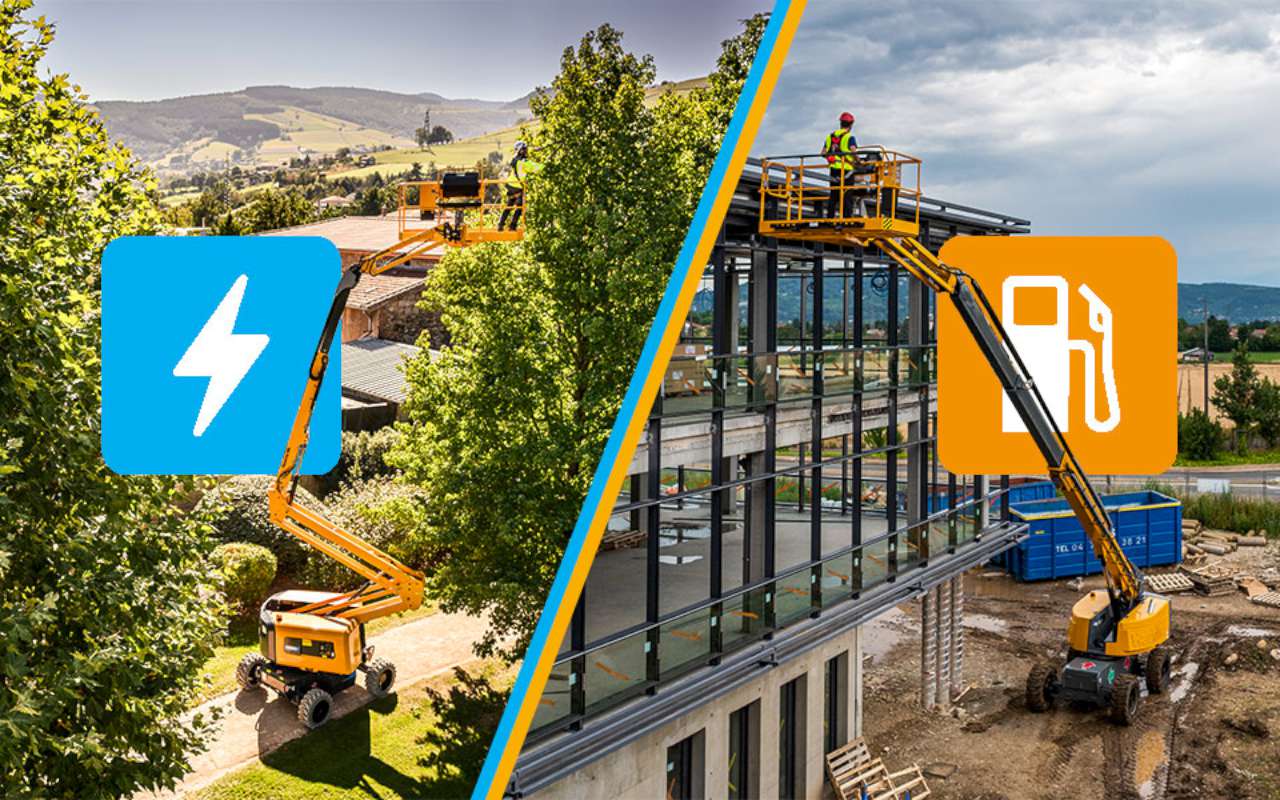We hear from MEWP manufacturers, Haulotte UK, who tell us wen we should be steering away from diesel platforms and using an electric lift.
Diesel lifts dominate rental fleets, making up about 70% of the inventory. Users of aerial work platforms typically rely on diesel models. However, for specific applications and job sites, electric lifts are essential and irreplaceable. This article outlines scenarios where an electric lift is your best choice.
Choosing between electric, diesel, or hybrid lifts depends largely on the work environment. Here’s a quick overview of each type:
Electric vs. Diesel vs. Hybrid Lifts: Key Differences
Electric Lifts:
These run entirely on electric batteries, making them much quieter than diesel models. They produce no CO2 emissions during use, aligning with various environmental regulations. However, their main drawback is limited battery life, though advancements in battery technology are improving this aspect.
Diesel Lifts:
Ideal for outdoor use, diesel lifts usually have longer runtimes than electric lifts. Their downside includes higher emissions and noise levels, which can be disruptive to both operators and nearby individuals.
Hybrid Lifts:
These offer flexibility by combining diesel and electric power. Haulotte’s PULSEO range, for example, lets operators switch between diesel and electric modes, adapting to different job site requirements.

When to choose an Electric Lift?
1. Low Emission Zones (LEZ) Projects
Low Emission Zones (LEZ) are a government tool for improving air quality. Their introduction is a response to the need to protect public health, particularly in large conurbations and cities. An EPZ is a zone where vehicle traffic is restricted, according to specific conditions defined by the local authority. In Europe, there are 320 EPZs*, all with the same objective: to protect the health of residents living in the most densely populated and polluted areas.
In Northern Europe, some construction sites in EPZs already restrict access by banning polluting equipment. In view of international climate agreements, we can imagine that regulations will become increasingly stringent over the next few years.
On construction sites located in the EPZ, the use of equipment emitting polluting emissions may be prohibited. In this case, electric or hybrid aerial platforms are the best solution, as they emit no pollutants (VOCs, NOX), and their absence is also a major advantage in densely populated areas.
2. Nighttime Urban Projects
Night work in urban centres imposes strict constraints in terms of noise pollution. In these circumstances, the site machinery authorized to work there must be able to justify a low noise level. Each site defines the admissible noise level, taking into account the surrounding conditions: type and duration of work, repetition of manoeuvres, proximity to dwellings, density of the surrounding population, etc.
Electric MEWPs, which are inherently silent, enable us to comply with these constraints, while guaranteeing the safety and efficiency of our operations. By limiting noise pollution, they minimize disturbance to nearby residents and workers.
3. Indoor Projects in Public Spaces
Construction sites in shopping malls, pedestrian precincts and airports require equipment that produces no emissions and little noise.
Electric aerial work platforms meet both these requirements perfectly, enabling work to be carried out in complete safety and without disrupting the activity of public places or critical infrastructures.
They are ideal for environments where cohabitation with the public is unavoidable.
4. Green Labelled or Non-Combustion Engine Projects
Construction projects with a « green » label, or those located in areas where combustion engines are prohibited (e.g. certain natural parks or protected areas), call for environmentally-friendly solutions.
Electric aerial platforms, with their zero emissions and silent operation, are the equipment of choice for these sites. They comply with strict environmental standards while delivering optimum performance.
5. Indoor/Outdoor Flexibility with PULSEO Range
Haulotte’s PULSEO range offers electric aerial work platforms for both indoor and outdoor use. These platforms combine the advantages of electric and diesel engines, offering great flexibility of use.
Operators can easily switch between modes, adapting the machine to the specific constraints of the worksite.
Whether for indoor work requiring low noise and zero emissions, or outdoor work requiring greater autonomy, the PULSEO range is the ideal solution!
Conclusion
Choosing between an electric and diesel lift depends on various factors like environmental constraints, noise levels, and specific job site requirements. Electric lifts are ideal for urban, nighttime, indoor, and green-labelled projects. Diesel lifts, however, remain a robust and autonomous solution for large-scale projects requiring prolonged use.
Hybrid lifts, such as those in Haulotte’s PULSEO range, offer unmatched versatility by combining the advantages of both technologies to suit a variety of situations. These models feature a removable and interchangeable Range Extender that quickly charges batteries, ensuring 80% battery charge in just three hours while maintaining full operational capacity. This is perfect for sites without electrical access.
Incorporating these lifts into your projects not only boosts operational performance but also supports environmental sustainability and the well-being of workers and residents.
